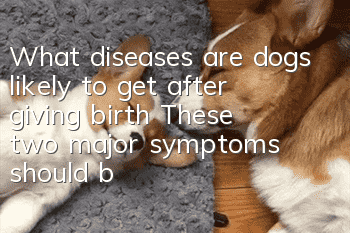What diseases are dogs likely to get after giving birth? These two major symptoms should be prevented in advance

Dogs are prone to mastitis after giving birth
The so-called mastitis refers to one or more mammary glands being infected by bacteria, and the cause of the infection can be caused by Ascending nipple infection, or infection caused by trauma to the breast, mastitis infection, if not properly treated, may cause fatal systemic infection.
Symptoms:
Dogs suffering from mastitis usually have a loss of appetite, poor energy, and neglect to take care of the puppies. The breasts will feel hard, swollen and warm when touched with hands. Most dogs will feel pain, and pus-like or bloody fluid will flow from the nipples. In severe infections, there will be lesions such as abscesses or gangrene on the breasts, and the bitch will have fever and dehydration.
How to treat:
Send to the pet hospital for treatment immediately. The doctor will give appropriate medication according to the condition. If dehydration or systemic sepsis occurs, fluid infusion is required. In addition, the milk must be expressed several times a day until the bitch's condition is under control. Of course, during the treatment period, the female dog cannot breastfeed, so it is necessary to help the puppy find a suitable "nanny" or switch to artificial breastfeeding.
How to prevent:
(1) Keep your mind clean.
(2) Shave the hair around the breasts and pay attention to the cleaning of the breasts.
(3) Trim the puppies’ toenails to prevent scratching the mother dog’s mammary glands when drinking milk.
Dogs are prone to convulsions (Eclampsia) after giving birth
Postpartum eclampsia is caused by postpartum hypocalcemia and more commonly occurs after delivery. 1-4 weeks, especially small dogs that give birth to their first litter. Hypocalcemia will cause changes in cell membrane potential, produce spontaneous nerve impulses, and then lead to tonic and clonic contractions of skeletal muscles. This type of situation can be fatal and should not be taken carelessly.
Symptoms:
(1) The female dog will become restless and nervous.
(2) Panting, breathing becomes faster, and whining.
(3) Stiffness in walking posture and movement disorder.
(4) Muscle tremors and twitching.
(5) However, 8-12 hours after the first symptoms occur, fatal muscle stiffness and falling to the ground may occur.
It is usually accompanied by a rise in body temperature, hypoglycemia, and dilated pupils that do not respond to light.
Risk factors for postpartum hypocalcemia:
(1) Excessive calcium supplementation during pregnancy.
(2) Puppies are larger or more numerous.
(3) Nutritional deficiencies before birth.
(4) Failure to pay attention to calcium supplementation during lactation.
How to treat:
Take it to the pet hospital quickly for treatment. The doctor will give calcium to relieve the pain.Slow intravenous injection can improve hypocalcemia. If the body temperature is too high, it can be combined with physical cooling. In the future lactation period, sufficient calcium should be supplemented.
How to prevent:
(1) Prevent excessive calcium supplementation during pregnancy.
(2) Female dogs must avoid foods high in phytic acid, such as whole grains, beans and other foods.
(3) For larger puppies, additional feeding can be given to reduce the burden of lactation on the mother dog.
(4) During the lactation stage, female dogs should supplement enough calcium.
- Is it better for Dogo dogs to have their ears erect or cropped? A case of Dogo dog’s ear erection surgery will tell you
- What do dogs eat to protect their stomach? It is important to protect their stomach and treat gastrointestinal diseases in dogs.
- How to tell if your dog is fat? Is your dog overweight?
- Will your dog catch a cold if you blow the air conditioner? What should you do if your dog catches a cold if you blow the air conditioner?
- What should you pay attention to when your dog drinks water? Don’t be careless when it comes to your dog’s drinking water.
- The dog's mouth bites and shakes. Why does the dog's mouth occasionally shake and bite?
- How to cut a dog's hair? Do you know how to cut a dog's hair correctly?
- Can dogs eat raw eggs? Why can’t dogs eat egg whites?
- Common Dog Problems in Summer How to Deal with Different Dog Problems
- How to keep dogs away from skin diseases. If you do this, will you see if your dog will still be infected with skin diseases?



